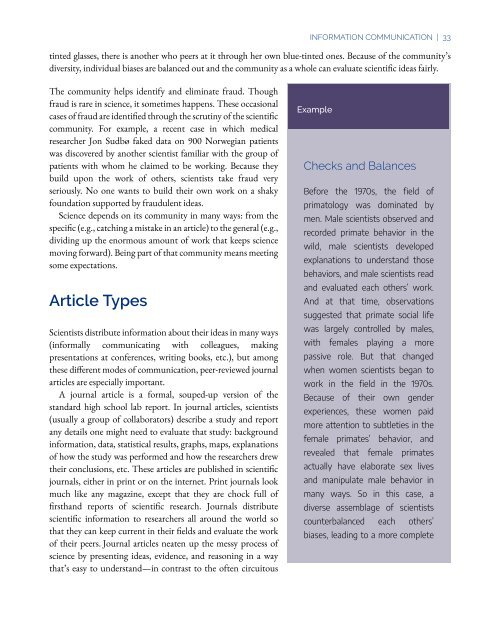An Interactive Introduction to Organismal and Molecular Biology, 2021
An Interactive Introduction to Organismal and Molecular Biology, 2021
An Interactive Introduction to Organismal and Molecular Biology, 2021
Create successful ePaper yourself
Turn your PDF publications into a flip-book with our unique Google optimized e-Paper software.
INFORMATION COMMUNICATION | 33<br />
tinted glasses, there is another who peers at it through her own blue-tinted ones. Because of the community’s<br />
diversity, individual biases are balanced out <strong>and</strong> the community as a whole can evaluate scientific ideas fairly.<br />
The community helps identify <strong>and</strong> eliminate fraud. Though<br />
fraud is rare in science, it sometimes happens. These occasional<br />
cases of fraud are identified through the scrutiny of the scientific<br />
community. For example, a recent case in which medical<br />
researcher Jon Sudbø faked data on 900 Norwegian patients<br />
was discovered by another scientist familiar with the group of<br />
patients with whom he claimed <strong>to</strong> be working. Because they<br />
build upon the work of others, scientists take fraud very<br />
seriously. No one wants <strong>to</strong> build their own work on a shaky<br />
foundation supported by fraudulent ideas.<br />
Science depends on its community in many ways: from the<br />
specific (e.g., catching a mistake in an article) <strong>to</strong> the general (e.g.,<br />
dividing up the enormous amount of work that keeps science<br />
moving forward). Being part of that community means meeting<br />
some expectations.<br />
Article Types<br />
Scientists distribute information about their ideas in many ways<br />
(informally communicating with colleagues, making<br />
presentations at conferences, writing books, etc.), but among<br />
these different modes of communication, peer-reviewed journal<br />
articles are especially important.<br />
A journal article is a formal, souped-up version of the<br />
st<strong>and</strong>ard high school lab report. In journal articles, scientists<br />
(usually a group of collabora<strong>to</strong>rs) describe a study <strong>and</strong> report<br />
any details one might need <strong>to</strong> evaluate that study: background<br />
information, data, statistical results, graphs, maps, explanations<br />
of how the study was performed <strong>and</strong> how the researchers drew<br />
their conclusions, etc. These articles are published in scientific<br />
journals, either in print or on the internet. Print journals look<br />
much like any magazine, except that they are chock full of<br />
firsth<strong>and</strong> reports of scientific research. Journals distribute<br />
scientific information <strong>to</strong> researchers all around the world so<br />
that they can keep current in their fields <strong>and</strong> evaluate the work<br />
of their peers. Journal articles neaten up the messy process of<br />
science by presenting ideas, evidence, <strong>and</strong> reasoning in a way<br />
that’s easy <strong>to</strong> underst<strong>and</strong>—in contrast <strong>to</strong> the often circui<strong>to</strong>us<br />
Example<br />
Checks <strong>and</strong> Balances<br />
Before the 1970s, the field of<br />
prima<strong>to</strong>logy was dominated by<br />
men. Male scientists observed <strong>and</strong><br />
recorded primate behavior in the<br />
wild, male scientists developed<br />
explanations <strong>to</strong> underst<strong>and</strong> those<br />
behaviors, <strong>and</strong> male scientists read<br />
<strong>and</strong> evaluated each others’ work.<br />
<strong>An</strong>d at that time, observations<br />
suggested that primate social life<br />
was largely controlled by males,<br />
with females playing a more<br />
passive role. But that changed<br />
when women scientists began <strong>to</strong><br />
work in the field in the 1970s.<br />
Because of their own gender<br />
experiences, these women paid<br />
more attention <strong>to</strong> subtleties in the<br />
female primates’ behavior, <strong>and</strong><br />
revealed that female primates<br />
actually have elaborate sex lives<br />
<strong>and</strong> manipulate male behavior in<br />
many ways. So in this case, a<br />
diverse assemblage of scientists<br />
counterbalanced each others’<br />
biases, leading <strong>to</strong> a more complete


















